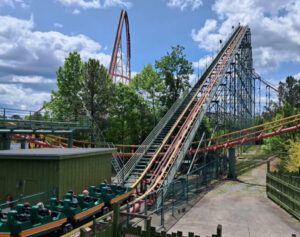Satoshi Egawa’s HARAJYUKU (2018) is an evocative oil on canvas painting that captures the vibrant and dynamic atmosphere of Tokyo’s Harajuku district. This yartwork is a visual exploration of the area’s unique subcultures, eclectic fashion, and energetic urban life. Harajuku, a globally recognized hub for youth culture and fashion innovation, serves as an ideal muse for Egawa’s expressive style. Through a combination of bold colors, gestural brushwork, and layered textures, the artist conveys the pulsating rhythm of the district and its cultural significance as a beacon of individuality and creativity.
The Cultural Significance of Harajuku
Harajuku is more than just a neighborhood in Tokyo; it is a cultural phenomenon that embodies the spirit of youthful self-expression and fashion experimentation. For decades, it has been a melting pot of styles ranging from the avant-garde to the traditional, where gothic Lolitas, punk-inspired outfits, and kawaii (cute) aesthetics coexist harmoniously. The district is famous for Takeshita Street, a narrow lane filled with colorful boutiques, independent designers, and a constant influx of trendsetters eager to showcase their creativity. Egawa’s HARAJYUKU distills this cultural vibrancy into a singular visual narrative, portraying the lively streets bustling with young individuals who redefine fashion norms.
In Egawa’s painting, the central figure—clad in a contemporary, stylish outfit—symbolizes the district’s role as a global trendsetter. The blurred motion surrounding the figure suggests the ever-changing nature of Harajuku fashion, where trends evolve rapidly, reflecting the fluidity of identity and self-representation. By situating the subject within a visually stimulating environment, Egawa underscores the district’s impact on personal expression and its broader influence on global fashion.
Artistic Techniques and Composition
Egawa’s use of oil paint in HARAJYUKU brings a sense of depth and texture to the artwork, enhancing the viewer’s engagement with the scene. The painting is characterized by several distinctive techniques:
Expressive Brushwork:
Egawa employs loose, gestural strokes that imbue the painting with energy and movement. This technique creates a sense of spontaneity, mirroring the fast-paced lifestyle of Harajuku’s residents and visitors.
Vivid Color Palette:
Bright and contrasting colors dominate the composition, reflecting the visual overload typical of Harajuku’s streets. Neon signage, colorful outfits, and eccentric accessories come to life through Egawa’s strategic use of bold hues.
Layered Texture:
Through thick applications of paint, Egawa adds a tactile quality to the artwork. The layers of color and form give the impression of a bustling crowd, with overlapping elements reinforcing the district’s dense, urban environment.
Dynamic Composition:
The central figure, though prominent, does not dominate the entire canvas. Instead, Egawa balances the figure within the chaotic urban landscape, allowing the eye to wander across various points of interest—shopfronts, lights, and bustling pedestrians.
The interplay of these techniques allows Egawa to capture not just the visual aspects of Harajuku but also the atmosphere—the noise, excitement, and constant state of change.
Themes Explored in HARAJYUKU
Egawa’s painting delves into multiple themes, reflecting both the microcosm of Harajuku and broader societal currents. Some of the key themes present in the artwork include:
Individuality vs. Conformity:
Harajuku is often seen as a space where individuality thrives, yet within this self-expression, certain trends become widely adopted, creating an interesting tension between uniqueness and conformity. Egawa captures this duality by depicting a singular figure amid a crowd, symbolizing both distinction and belonging.
Urban Energy and Movement:
The painting pulsates with movement, highlighting the dynamic nature of urban spaces. Egawa’s portrayal of bustling streets filled with shoppers, photographers, and onlookers emphasizes the transient quality of the Harajuku experience.
Culture
Harajuku’s identity is shaped by a blend of Western and Japanese influences. From traditional kimono elements integrated into modern streetwear to Western pop culture references, the district embodies a unique fusion that Egawa encapsulates in his artwork.
Consumerism and Commercialization:
While Harajuku is celebrated for its authenticity and grassroots creativity, it is also a commercial powerhouse. The painting hints at the commodification of subcultures, as branded stores and flashy advertisements become integral parts of the visual landscape.
Influences and Artistic Context
Egawa’s work is influenced by both traditional Japanese art and contemporary street culture. The layered approach and emphasis on color and movement draw inspiration from ukiyo-e woodblock prints, which similarly depicted urban life in Edo-period Japan. At the same time, Egawa’s engagement with contemporary subject matter places his work within the context of modern urban realism, akin to the works of Western artists such as Edward Hopper, who explored themes of city life and isolation within bustling environments.
Furthermore, Egawa’s HARAJYUKU can be seen in dialogue with other Japanese contemporary artists who document urban culture, such as Takashi Murakami and Yoshitomo Nara. While Murakami’s work often takes a more pop-art approach, Egawa’s painting leans towards a rawer, more immediate representation of street life.
Viewer Experience and Interpretation
Upon viewing HARAJYUKU, one is immediately drawn into the sensory overload of the depicted scene. The layers of color, the implied noise, and the diversity of elements present create an immersive experience. The painting invites viewers to reflect on their own experiences with urban spaces and the way culture shapes personal identity. The central figure’s ambiguous expression allows for multiple interpretations—are they lost in thought, overwhelmed by the chaos, or reveling in the vibrancy of their surroundings?
For those familiar with Harajuku, the painting serves as a nostalgic reminder of the district’s iconic streets. For others, it provides a glimpse into a world that is both uniquely Japanese and universally relatable in its celebration of youth culture and individuality.
Satoshi Egawa’s HARAJYUKU (2018) stands as a powerful visual testament to one of the world’s most culturally significant neighborhoods. Through his masterful use of color, texture, and composition, Egawa captures the essence of Harajuku’s ever-evolving fashion scene, its bustling energy, and its role as a cultural epicenter. The painting not only celebrates the district’s vibrancy but also prompts reflection on the broader themes of identity, consumerism, and cultural hybridity.
Whether viewed as a documentation of a specific place and time or as an exploration of universal themes related to self-expression and urban life, HARAJYUKU remains a compelling piece of contemporary art that continues to resonate with audiences worldwide. Egawa’s work ensures that the spirit of Harajuku, with all its color and chaos, is preserved on canvas for future generations to appreciate and analyze.
No comments yet.








